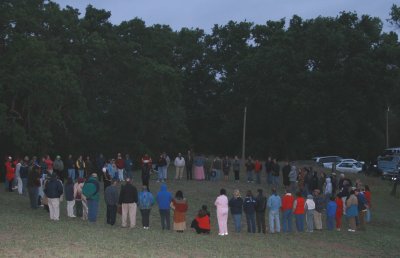- Elizabeth Larson
Bloody Island atrocity remembered at Saturday ceremony

UPPER LAKE – It's been more than 150 years since the US Army marched into Lake County and killed dozens of Pomo natives, but the pain and horror of the event continues to reverberate for local Pomo today.
About 102 community members of many backgrounds for a sunrise ceremony on Saturday to commemorate the 157th anniversary of the 1850 massacre.
Saturday's event wasn't just about remembering, it was also about looking positively at the future for the county's native cultures.
The event has been led and organized over the years by Clayton Duncan of Robinson Rancheria, a descendant of Ni'ka, also known by her Anglicized name, Lucy Moore.
Duncan's Web site reports that Moore was a 6-year-old child when the massacre took place, and she reportedly survived by going into the lake and hiding underwater, breathing through a tule reed.
Speaking at the event along with Duncan was his brother, Doug, and Elem tribal administrator Jim Brown. The speakers at the event focused on the positive, hoping for healing and greater understanding amongst the cultures living side by side in Lake County today.
Six young Pomo dancers in traditional costume danced and chanted. Duncan explained that the dances and songs were offered as signs of forgiveness for what happened on the land so long ago.
The dancers, said Duncan, were welcoming the opportunity to once again dance and sing on the land after 157 years.
Accounts of the Bloody Island massacre
Historical accounts from sources including Henry K. Mauldin, the National Park Service, and Pete Richerson and Scott Richerson of UC Davis, report that the events that led to the Bloody Island Massacre – also called the Clear Lake Massacre – began in 1849, when years of mistreatment of native Pomo by Charles Stone and Andrew Kelsey came to a head.
Stone and Kelsey – “in the grip of gold fever,” according to the Richersons' account – forced 50 Pomo men to go with them to the gold fields as laborers. They then sold the rations for the Pomos to the miners, which resulted in all but one or two of the Pomos starving to death.
The Pomos who remained at home in Lake County weren't faring much better. Stone and Kelsey were reportedly giving inadequate food rations – four cups of wheat a day for an entire family – to the native laborers.
When one young Pomo man was sent by his starving family to Stone to ask for more wheat, Stone killed him.
Not long after that murder, two Pomo men, Shuk and Xasis, decided to go hunting for meat to feed their hungry village, and borrowed horses from Stone and Kelsey to do it, according to an account by Pomo interpreter William Gibson, as featured on the Elem Nation Web site.
Shuk and Xasis didn't manage to bring back any meat, and were concerned they would be killed if it was found out that they had taken the horses.
At about this time, to add insult to injury, Stone and Kelsey “remained as carelessly brutal as ever, beating, even shooting, men on drunken whims. Women were raped and enslaved.” That included abducting the wife of Chief Augustine, the leader of the local Pomo band, and keeping her at their home.
Deciding to go on the offensive, in December 1849 Shuk and Xasis, joined by Chief Augustine and a few other Pomos, attacked the home of Stone and Kelsey. Inside the home, Chief Augustine's wife poured water on Stone and Kelsey's gunpowder toruin it.
Mauldin said Kelsey was killed by an arrow. Stone escaped and hid in a clump of willows on Kelsey Creek, where an Indian found him and killed him with a rock. The Pomos then took food supplies back to the village.
Many of the Pomo who had been victimized by Stone and Kelsey fled to the area of Bloody Island, which was the site of an established village.
Mauldin's history reports that Bloody Island was known by the Pomo as Badon-napo-ti, which means “old island.” The site is located one-quarter mile west of today's Highway 20 and about one and one-half miles south of the town of Upper Lake.
The historical accounts say that a US Army company, led by Captain Nathaniel Lyon – who had recently fought in Mexico during the Mexican-American War – came to Lake County in the spring of 1850 to punish Chief Augustine's band of Pomos for Stone's and Kelsey's deaths. The Army forced the Elem Pomo to supply two guides for the expedition.
The Army went through Big Valley and didn't find the band. The Army then traveled toward modern-day Upper Lake, coming upon an unknown band of Pomos.
The Army used whaleboats and two small brass cannons from the Benicia Army arsenal, as well as rifle fire, to attack the band.
The numbers of native victims vary. The accounts report that the Army killed their two Elem guides; the National Park Service reported that 60 of the 400 Pomo on the island died.
Mauldin puts the deaths at about 100. He wrote that men, women and children were killed, with soldiers spearing infants with their bayonets and flinging them into the tules. Mauldin added there were no casualties among the soldiers.
The same Army company killed 75 Indians on the Russian River shortly thereafter.
Following the massacre, Pomo leaders negotiated treaties with government agents, but those treaties were never approved, according to historical accounts.
Lyon would later be promoted to brigadier general and lead Union forces in Missouri during the early days of the Civil War. He was shot several times and died on Aug. 10, 1861, during the Battle of Wilson's Creek.
Harold LaBonte contributed to this report.
E-mail Elizabeth Larson at


{mos_sb_discuss:2}


 How to resolve AdBlock issue?
How to resolve AdBlock issue? 



